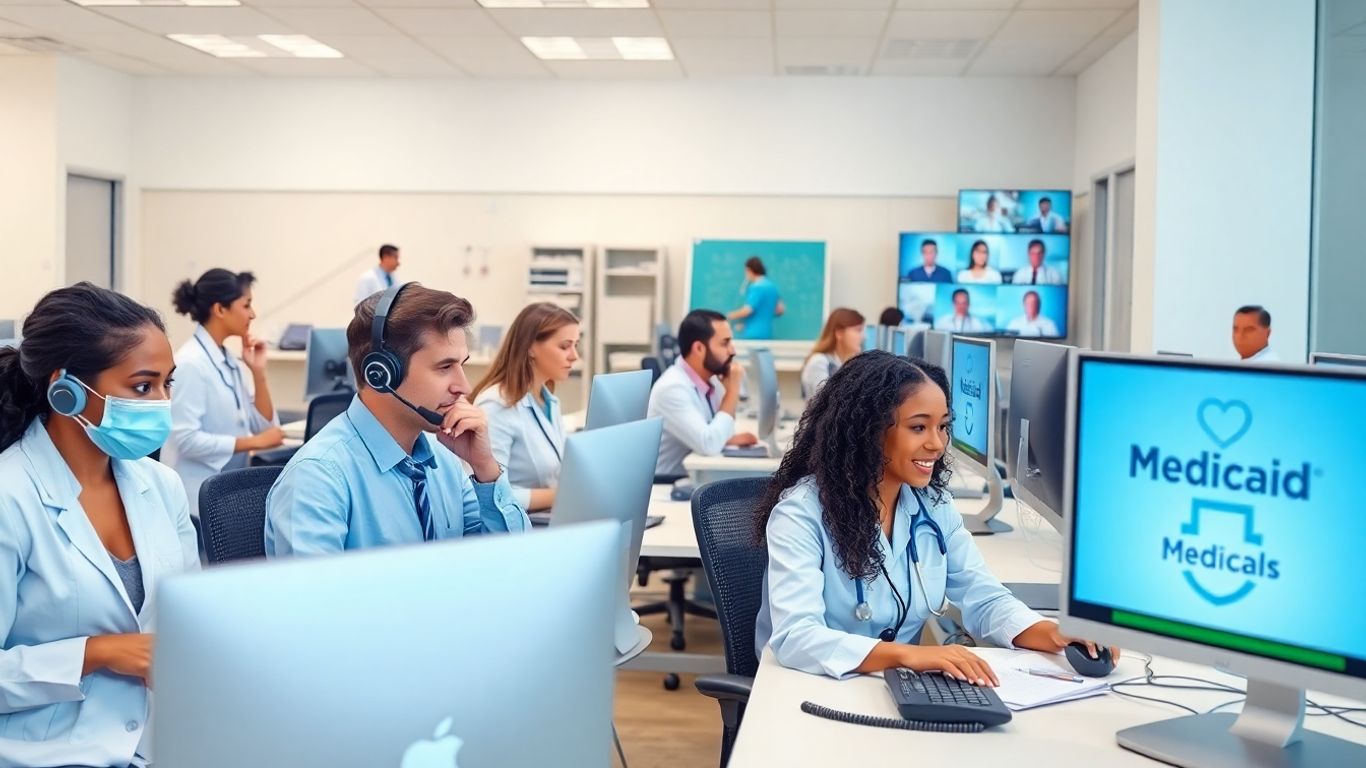Ever tried calling a doctor's office only to get stuck on hold forever? Or maybe you needed to reschedule a Medicaid ride but couldn't get through. It's frustrating, and honestly, it shouldn't be this hard. That's where a Medicaid answering service comes in. In 2025, these services are getting smarter, faster, and a whole lot more helpful for patients and providers. From booking rides to making sure paperwork is in order, they're changing how people get care—especially for those who need it most. Let's look at how this tech is making a real difference.

Getting in touch with a healthcare provider should be easy, yet that's rarely the reality for Medicaid patients. A Medicaid answering service rethinks the entire first point of contact—using AI tools to cut out the friction.
The average patient waits on hold, gets frustrated, then gives up or forgets why they called in the first place. AI answering systems don't take breaks or stick to 9-to-5. They handle calls instantly—no more dreaded voice prompts or complicated menus.
Key outcomes from real-time, AI-enabled scheduling:
Check out how AI front desk and answering services are making 24/7 patient access a reality across healthcare.
Non-Emergency Medical Transportation isn’t just a niche service—it’s a lifeline for millions. AI answering platforms can talk directly to patients, instantly route requests to local NEMT providers, confirm eligibility, and push out notifications to all parties. It just happens without the need for human juggling.
What smooth coordination means in practice:
No more missed rides or endless callbacks.
If no one answers, patients fall through the cracks. An automated Medicaid answering service fixes this by responding the moment a call or message comes in. Whether it’s rescheduling, prescription questions, or finding urgent care—patients are never left waiting.
Speed and reliability at the first point of contact change everything for Medicaid patients—they’re more likely to stay on track with their care and show up for appointments when answers are always just a call away.
The old model just can’t keep up. These new digital front desks are already quietly transforming access for those who need it most.

Confirming Medicaid eligibility feels endless, especially with manual document checks. An AI-driven answering service can scan uploaded documents, extract key info, and match the data with patient records in seconds. This cuts out repetitive data entry and trims human error, so more applications get processed on the first pass. A side benefit? Fewer denials and terminations because files are categorized and verified faster.
When eligibility checks run on autopilot, frontline staff spend less time chasing paperwork and more time helping patients who need extra support.
Billing for Medicaid is complicated. There’s code matching, claim tracking, and chasing authorizations. But modern AI receptionists—like those using advanced workflows and Zapier integrations (over 9000 app connections)—can take much of this off your plate. Calls and messages sync with billing systems, data entry vanishes, and common errors drop.
Here’s a quick comparison table:
Medicaid rules are constantly shifting. Keeping up drains time—mistakes can be costly. With an AI-driven answering service, scripts and workflows update automatically for policy changes or state-specific requirements. This keeps your documentation consistent and up-to-date, no matter what twists appear in the regulations.
Using smart automation, providers can finally focus on care instead of endless paperwork. Learn more about a 24/7 answering assistant's capabilities for regulated practices in this overview of virtual receptionist solutions.
The biggest problem in healthcare isn’t technology or even policy changes. It’s people not being able to reach each other. That’s where a Medicaid answering service can help: it acts fast, answers questions, and keeps lines open both ways.
Most medical needs don’t wait until 9 to 5. Patients dealing with Medicaid often have more questions, unusual schedules, or language barriers than average. Round-the-clock support means somebody always picks up—no more voicemails or unreturned calls. If a patient needs help in Spanish or Mandarin at 2 AM, instant translation makes sure nothing gets lost.
Main outcomes:
When your answering service speaks the patient’s language and keeps the lights on 24/7, routine confusion and frustration turn into clarity and confidence.
So many appointments are lost because the reminder never comes. Texts—sent at the right time, not hours or days too late—make a difference. AI-driven rules can send the right follow-up to remind someone about forms, confirm rides, or ask if they need anything else. This isn’t just about efficiency; it’s about consistency.
Example workflow table:
A robust system does these things automatically—cutting out manual errors and improving overall engagement. According to enhancing communication with dental clinic staff, clear, prompt outreach leads directly to better patient experiences in clinical settings.
Nothing hurts Medicaid patients more than lost time: missed rides, confused schedules, and phone tag. A dedicated service:
This cuts down walkaway rates and the endless cycle of rescheduling. The bottom line? Patients get care when they’re supposed to, and providers stop losing hours to confusion.
By tackling communication head-on—with tech, staffed support, and practical tools—a Medicaid answering service helps everyone focus on what actually matters: access to care, not chasing paperwork or playing phone tag.
Nobody gets excited about spreadsheets, but the honest truth is, data actually decides if a Medicaid answering service does what it promises. If you’re managing thousands of patient calls and appointments every week, it’s not just about picking up the phone. It’s about what happens to all that information. Smart use of data is what sets great systems apart from the rest.
Most clinics stare at vague charts and hope things are going well. In reality, you need a dashboard that actually answers, “Are patients getting seen?” and “Where do we keep dropping the ball?”
Here’s what actionable analytics should look like:
There’s nothing slower than someone copying info from one system to another. The best Medicaid answering services just sync with EHR tools and health IT platforms—no manual double entry, no accidental typos.
This means less paperwork and a better chance the right info makes it to the people who need it—quickly.
Reports used to mean hours lost on clerical tasks. Now, the right answering service should pull together:
When new Medicaid rules roll out, it’s the clinics with solid data systems that adapt fast. No guessing, just numbers you can share at meetings and audits.
Building a Medicaid answering service that uses real-time data means staff actually know what’s happening, patients get answers, and nobody’s stuck hunting for numbers at the end of the month.
Picture a medical office running on sticky notes and disjointed phone calls. Now picture one where everything actually syncs. That’s where a Medicaid answering service steps in, automating the background noise and actually connecting all the tools teams rely on.
The smartest answering services aren’t just another line in the call log. Instead, they tap right into calendars, practice management software, billing tools, and more. Here’s what that can look like:
It’s the glue that keeps clinical, billing, and patient communication teams on the same page.
Modern services play nicely with CRM platforms and patient communication tools. Instead of chasing charts or waiting for faxes:
When patient issues pop up, every second counts. The right answering service doesn’t just forward voicemails; it:
Constant context-switching burns out staff and slows down care. Smart integration puts the right info in front of the right person, fast.
The goal here isn’t just reducing errors (though that’s a huge plus)—it’s about making healthcare teams work together without tripping over their own tools. Each integration pushes a little less chaos and a little more actual progress into the day.
Running a Medicaid practice is a math problem as much as a clinical one. You’re watching budgets, reimbursements, staffing, and call volume—every penny counts. Switching to a Medicaid answering service is one of those rare moves that actually gives you more control over your costs, not less.
Having clear boundaries on what you pay for helps you sleep at night. The ability to set max minutes or calls for your answering service is huge:
Sticking to your budget is a lot easier with these controls, and it puts you in charge, not the vendor. Many modern services, like those from AI Phone Receptionist offers customizable plans, include these settings as standard.
There’s something nice about knowing your bill won’t surprise you. Monthly subscriptions or tiered plans help you forecast expenses. Here’s how that shakes out for Medicaid clinics:
You end up with a service that adjusts to you—not the other way around.
Too many clinics waste thousands staffing for the worst-case scenario. With modern answering services, you only scale up when you actually need to. No more paying for idle time or scrambling during a rush.
When you use a set-and-forget resource like an AI-powered answering service, you stay ready for spikes without burning money on extra personnel or temp agencies. That buffer alone can save practices anywhere from 10-30% in annual call-handling costs.
If you’re still running things the way you did five years ago, you’re probably overpaying somewhere. Medicaid answering services take half of the guesswork out of your operations, giving you numbers you can actually work with.
Plain and simple: better control, less waste, fewer financial surprises.

Getting quality healthcare in rural spots still feels almost impossible for some people. Long drives, few clinics, and difficult coordination — these don’t just waste time, they’re a real obstacle. AI-powered answering services break down these barriers by intelligently routing patient calls and requests based on location and urgency.
Picture a Medicaid patient in a town with one clinic, miles away from any pharmacy or hospital. With smart routing:
Making care accessible shouldn’t depend on your ZIP code or cell reception. Smarter answering services help flip the script for people who’ve always had to wait, travel, or go without.
Telehealth isn’t just a convenience in rural areas — it’s often the only shot at seeing a provider. Medicaid answering services are starting to cover real gaps by setting up telehealth appointments directly during calls, even when patients aren’t calling from their own homes. This kind of instant connection:
New Medicaid rules keep rolling out, and rural clinics are usually the last to hear about them. AI-driven answering services step in to bridge that policy gap, keeping clinics and patients informed.
Medicaid support isn’t just about medical appointments. It’s about removing friction, confusion, and distance from people’s path to care. Even innovations in oral health, like clearly communicating the link between preventive visits and long-term wellness, depend on trust and clear access, which the right technology finally brings to lasting relationships for rural patients.
People living in small towns or far from big cities often find it hard to get the help they need. With Frontdesk, our smart AI receptionist makes it easier to connect with businesses any time, day or night. Don’t let distance stop you. Visit our website and see how we open doors for everyone, no matter where you’re from!
So, here’s the bottom line: a Medicaid answering service isn’t just a nice-to-have anymore—it’s becoming a must for patient support and access, especially as we head into 2025. With smarter tech, real-time updates, and easier ways to handle calls and scheduling, patients get answers faster and providers waste less time on the phone. It’s not magic, but it does make things run smoother. The trick is keeping it simple and reliable. If you’re still using old-school systems, you’re probably missing out on better patient experiences and maybe even losing money. The future’s about meeting people where they are, and a solid answering service is a step in that direction. It’s not perfect, but it’s a lot better than the alternative.
A Medicaid Answering Service is a special phone service that helps patients with Medicaid get answers, schedule rides, and set up doctor appointments. It uses smart technology to make sure patients get help fast, even after regular office hours.
The service uses AI to quickly find open times for appointments and rides. It can send reminders by text or call, so patients are less likely to forget or miss their appointments.
Yes, many Medicaid Answering Services can help patients in different languages. This makes it easier for people who don’t speak English well to get the care they need.
The answering service can check if a patient is eligible for Medicaid and help fill out forms. It also keeps records and sends the right paperwork to Medicaid, which helps doctors and clinics follow the rules.
Yes, it helps clinics control costs by letting them set limits on how much the service is used. It also helps manage busy times better, so clinics don’t have to hire extra staff for short periods.
Yes, these services are great for rural and underserved areas. They use smart routing and even connect with telehealth, so people far from clinics can still get help and set up appointments.
Start your free trial for My AI Front Desk today, it takes minutes to setup!








